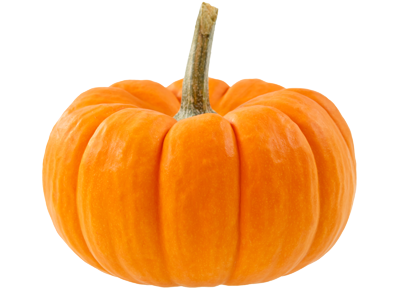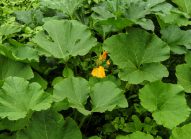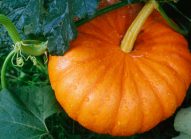Health
benefits
Sunshine in winter!
Winter squashes (pumpkins) and red kuri squashes have a high water content, like all vegetables in the gourd family, and are rich in provitamin A (beta-carotene). This vitamin favors iron metabolism, tissue health, night vision, immunity, and growth.
Winter squashes (pumpkins) and red kuri squashes are also:
- a source of potassium (for the nervous system, muscular function, and blood pressure)
They also contain:
- vitamin C
- vitamin B9
- manganese
- antioxidants (lutein, zeaxanthin, and beta-cryptoxanthin)
Nutritional
composition
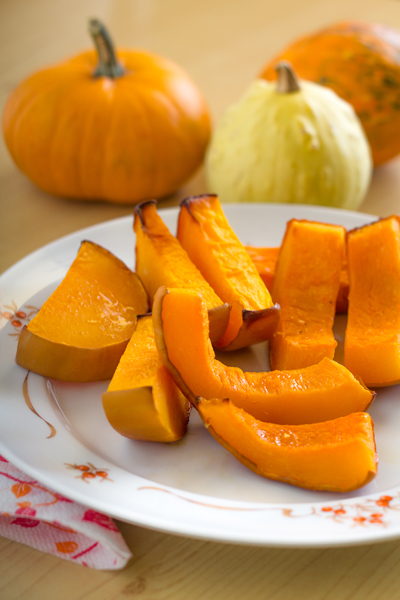
When is the right
time to eat them?
Fall and winter
Winter squashes (pumpkin) and red kuri squashes keep well and are available year-round. However, they are mainly eaten in the middle of fall and winter, from October to January.
-
January
-
February
-
March
-
April
-
May
-
June
-
July
-
August
-
September
-
October
-
November
-
December
Vegetable patch
or urban balcony?
Winter squash is an herbaceous annual that grows well in rich, well-drained soil, in full sun.
Red kuri squash grows on an annual, creeping, tender plant that grows well in rich, deep, cool, light, well-drained soil rich in humus, in sunny spots.
To learn everything you need to know about growing winter squash, read the page on growing advice.
Choosing and
storing
Choose your winter squashes (pumpkins) and red kuri squashes well:
- Winter squashes and red kuri squashes should be smooth and firm, with no spots on the skin.
- Smaller winter squashes and red kuri squashes are better than bigger ones, as their flesh is more tender.
- Their flesh should smell good and not be slimy.
- Choose ones that still have their stem, as they will last longer.
Properly store your winter squashes (pumpkins) and red kuri squashes:
- In a cool, dry space: whole, away from light for several months
- In the refrigerator: cut, in plastic wrap, for three to four days..
- In the freezer: blanch them before freezing.
Tips and
tricks
How to prepare winter squashes (pumpkins) and red kuri squashes
They are extremely easy to prepare. Do not peel them! Their skin becomes tender once they are cooked, and is edible. Red kuri squashes have thinner skin than winter squashes.
Cut them in half and remove the seeds only (they are edible, too).
Cooking time::
- 15 min: in the pressure cooker
- 40 min: in the oven
- 20 min: in boiling water
Anti-waste tip: Just like pumpkin seeds, red kuri squash seeds can be roasted in the oven (20min) with a bit of olive oil and some spices (curcuma, curry, or others). They are great as a starter or to add some crunchiness to soups and salads.
Winter squashes (pumpkins) and red kuri squashes go well with
Raw: It is less common to eat raw winter squashes or red kuri squashes, but it is possible, and unique! Dice them and serve them with citrus fruits and/or mangoes, fresh herbs, and a slightly sweet vinaigrette. Delicious! They can also be grated and are a wonderful substitute or addition to grated carrots in salads with raisins and hazelnuts, or any other dried fruits or nuts.
Cooked: They add a splash of color and richness to soups, risottos, stews, and curries. They are also delicious in gratins and purées.
They pair well with onions, grapefruit, fresh herbs, dried beans, maple syrup, fennel, goat cheese and parmesan, olive oil, eggs (in a flan), potatoes, dried fruits, and more.
Slightly sweet, they are used to make desserts (pies, cakes, muffins, and even sorbets) with a beautiful shade of orange.
Can everyone
eat them?
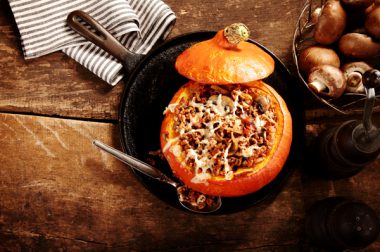
Young children
Starting at 12 months, children will like winter squashes or red kuri squashes in soups, purées, and desserts (cakes, sweets, etc.).
And everyone else
Almost everyone likes their slightly sweet taste.
See plenty of other tips for encouraging children to eat vegetables
Where do they come from?
Origins and varieties
Origins: The countries that produce the most winter squashes are China, India, and Russia.
Red kuri squash is originally from Japan, which is still the main producer, followed by Germany, France, the Netherlands, England, and the United States.
Varieties: Winter squashes (Cucurbita maxima) are the oldest squashes. They are round, ribbed, and flat at the two extremities. Their skin is very tough, and they can be yellow, orange, or green depending on the variety:
- The “rouge vif d’Étampes” winter squash (lit. bright red Étampes squash) is the most common variety [in France]. It is very big, with an orange-red color on the outside and thick orange flesh.
- The “Bronze de Montlhéry” is a greenish-brown, ribbed winter squash.
- The “Potiron jaune” (lit. yellow winter squash), also called “courge romaine jaune” (lit. yellow Roman squash) has pinkish yellow skin that splits when it is ripe.
- The “Potiron vert d’Espagne” (lit. Spanish green winter squash) is fairly rare.
Pumpkin or winter squash?
One is often mistaken for the other. In English, the word “pumpkin” is often used for both, and the same trend is seen in French with the word “citrouille” (pumpkin) replacing “potiron” (winter squash) because of the repeated influence of English during Halloween and in Disney movies (where Cinderella’s carriage turns into a pumpkin, not a winter squash).
However, a winter squash is not a pumpkin! Winter squashes – like red kuri squashes – belong to the Cucurbita maxima species. Pumpkins belong to the Cucurbita pepo species. They are not as wide as winter squashes, smaller, and more orange, and are used for animal feed.
For Halloween, people carve winter squashes, not pumpkins (technically).
